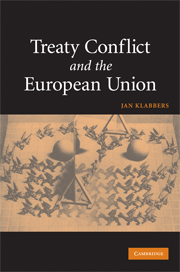Book contents
- Frontmatter
- Contents
- Preface
- Table of cases and official materials
- Table of treaties and instruments
- PART I Setting the scene
- PART II International law
- PART III EC law
- 6 The EC and anterior treaties
- 7 The UN Charter and the European Convention
- 8 Posterior treaties: conceptual issues
- 9 Posterior treaties: practice
- 10 Conclusions
- Bibliography
- Index
7 - The UN Charter and the European Convention
Published online by Cambridge University Press: 03 February 2010
- Frontmatter
- Contents
- Preface
- Table of cases and official materials
- Table of treaties and instruments
- PART I Setting the scene
- PART II International law
- PART III EC law
- 6 The EC and anterior treaties
- 7 The UN Charter and the European Convention
- 8 Posterior treaties: conceptual issues
- 9 Posterior treaties: practice
- 10 Conclusions
- Bibliography
- Index
Summary
Introduction
It has become standard practice for the Court of Justice, at least since Burgoa, to hold that article 307 ‘is of general scope and applies to any international agreement, irrespective of subject-matter, which is capable of affecting application’ of the EC Treaty.1 All treaties are equal, but some, as they say, are more equal than others: there are good reasons to devote separate treatment to the relationship between two specific treaties and EC law.
First, there is the relationshipwith theUNCharter to consider.Not only is the UN Charter sometimes considered as a constitution for the world community, it also has its own clause on treaty conflict: it demands priority, and does so in no uncertain terms. These two characteristics together warrant a special investigation into the attitude of the Community courts when confronted with UN law.
Second, there is the European Convention on Human Rights and Fundamental Freedoms which, at least in the eyes of the Court overseeing its implementation and application, is also of a special nature, creative as it is of ‘objective obligations’. Indeed, the same Court has even qualified it as ‘a constitutional instrument of European public order’. If that claim is to be taken seriously, it too could perhaps demand to be given priority over conflicting EC law. Moreover, an analysis of the Convention in terms of article 307 TEC might be problematic, as not all EU members had ratified the Convention when joining the EU, with France being the textbook example.
Both the UN Charter and the European Convention, then, could provide a strong argument as to why, in case of conflict, conflicting EC law should give way.
- Type
- Chapter
- Information
- Treaty Conflict and the European Union , pp. 150 - 174Publisher: Cambridge University PressPrint publication year: 2008



